Keywords
Infection control; Catheterization; Urinary tract infection; Nurses knowledge; Practise.
Abbreviations
CDC Center for Disease and Control; CUATI Catheter Associated Urinary Tract Infection; UTI Urinary tract infection; IUC Indwelling Urinary Catheter; ANOVA Analysis Of Variance; HAIs Health Care Associated Infections; SPSS Statistical Package for the Social Sciences.
Background
Urinary Tract Infections (UTIs) accounts for at least 35% of all hospital acquired infections with 80% of those being qualified to the use of indwelling catheters. In addition to the impact on quality of life, Catheter Associated Urinary Tract Infection (CAUTIs) places a financial burden on the health care system in term of treatment and increased length of stay. The exact cost of CAUTI is difficult to calculate due to changes in clinical and billing practises [1].
Indwelling urinary catheters are widely used, with an estimated 15% to 25% of hospitalized adults having an indwelling catheter for a portion of their hospitalization. [2] Indwelling catheters promote bacteriuria and funguria which in most cases is symptomatic and should not be treated. However, because of the large number of catheters used, even the small proportion of catheter-associated urinary tract infection (CAUTI) episodes that are symptomatic cause substantial problems. [3]
A study about intervention to improve professional adherence to guidelines for prevention of devicerelated infections in different countries United Kingdom, Brazil, Canada appeared to show that Health Care Associated Infections (HAIs) are a major threat to patient safety, and are associated with mortality rates varying from 5% to 35%. [4] Important risk factors associated with HAIs are the use of invasive medical devices (e.g. urinary catheter), and poor staff adherence to infection prevention practises during insertion and care for the devices when in place. [5] There are specific risk profiles for each device, but generally the breakdown of aseptic technique during the insertion and care for the device, as well as the duration of device use, are important factors for the development of these serious and costly infections. Most often it is observed that a patient comes to hospital for treatment of particular arrangement, but has acquired on infection prolonging and has hospital stay, sometimes leading to septicemia, multisystem organ failure, and death. [6] Hospital acquired infections are not only the problem of the patients but also the patient’s families, hospital staff, and the community.
A study about intervention to improve professional adherence to guidelines for prevention of devicerelated infections in different countries United Kingdom, Brazil, Canada appeared to show that Health Care Associated Infections (HAIs) are a major threat to patient safety, and are associated with mortality rates varying from 5% to 35%. [4] Important risk factors associated with HAIs are the use of invasive medical devices (e.g. urinary catheter), and poor staff adherence to infection prevention practises during insertion and care for the devices when in place. [5] There are specific risk profiles for each device, but generally the breakdown of aseptic technique during the insertion and care for the device, as well as the duration of device use, are important factors for the development of these serious and costly infections. Most often it is observed that a patient comes to hospital for treatment of particular arrangement, but has acquired on infection prolonging and has hospital stay, sometimes leading to septicemia, multisystem organ failure, and death. [6] Hospital acquired infections are not only the problem of the patients but also the patient’s families, hospital staff, and the community.
A study about knowledge regarding catheter care among staff nurses was conducted in Nellore appeared to show that the majority of staff nurses 46% had adequate knowledge, 33% had moderately adequate knowledge and 20% had inadequate knowledge regarding catheter care. [7]
A research study was conducted in New-York University showed that prevention practises commonly followed included wearing gloves (97%), hand washing (89%), maintaining a sterile barrier (81%) and using a no-touch insertion technique (73%). Silver-coated catheter was used to varying the degrees in (59%) of the hospitals; 4% reported, never using a catheter securing device. Urethral metal care was provided daily by 43% of hospitals and more frequently that by 41% of hospital. Nurses were the most frequently reported Intra Urinary Catheter (IUC) inserters. [8] Training in aseptic technique and CAUTI prevention at the time of initial hiring was provided by 64% of hospitals; however, only 47% annually validated competency in IUC insertion. Systems for IUC removal were implemented in 56% of hospitals. IUC documentation and routine CAUTI surveillance practises varied widely. [9]
Approximately 12%-16% of adult hospital inpatients may have indwelling urinary catheter at sometimes during their hospitalization, and each day the indwelling urinary catheter remains, a patient has a 3%-7% increased risk of acquiring catheter associated urinary tract infection. [10] CAUTI can lead to such complications as prostatitis, epididymitis, and orchids in males, and cystitis and pyelonephritis, gram-negative bacteremia, endocarditis, vertebral osteomyelitis in overall patients.5 Complications associated with CAUTI cause discomfort to the patients, prolonged hospital stays, and increased cost and mortality. It has been estimated that each year, more than 13,000 deaths are associated with UTIs. [11] Catheter associated urinary tract infections are the most common types of health care associated infections, accounting for more than 30% of the health care associated infections reported by acute health hospitals [Center for Disease and Control (CDC), 2012]. [12]
Studies on infection control knowledge exchange in some places. In India, it was found in a study of 329 nurses’ knowledge about infection control was poor. The nurses’ knowledge of infection control and transmission of blood pathogens were uniformly poor and their awareness was significantly less compared to the doctors. [13]
In addition, in the United States, a study conducted under 150 nurses revealed that nurses’ knowledge about infection control was limited. Nurses did not identify any perceived barriers or possible indications to act upon and to increase the likelihood of engaging in proper infection control practises. [14]
Further findings brought in the study of 306 nurses in South Korea indicated that nurses’ knowledge about the basic concepts of infection control and environmental management remained inadequate. Nurses are relatively non-compliant to the guidelines in the field of education (staff, patients, family) and communication. [15]
According to a study in 2006, the majority of hospital acquired UTIs are associated with having an indwelling urinary catheter, but the risk of the achievement of a UTI depended on the method of catheterization, duration of catheter use, quality of catheter care, and host susceptibility. [16]
Purpose
The purpose of this study was to explore practise of nurses in private tertiary care hospitals regarding urinary catheter care. The study also focused on the current knowledge of nurses regarding urinary catheter care.
Research Questions
• What do nurses know about urinary catheter care?
• What are nurses’ standards of practises regarding urinary catheter care?
Significance
This study was important to explore practise regarding urinary catheter care in private tertiary care hospital Peshawar. The hospital infection control management to take appropriate action for lack of current practises toward standard practise for urinary catheter care which can minimize urinary catheter related infection and improve patients care. The result of the study would enhance nursing practise about standard care regarding urinary catheter care and identified gap for further work on the use of standard guidelines within hospital. [17]
Methodology
Study Design
This research project was conducted at private tertiary care hospital in Peshawar from November (2016) to December (2016). The research design used for this study was a quantitative research, which is a descriptive cross-sectional design.
Population and Setting
The selected hospital was a private tertiary care hospital of Peshawar. The study population was nursing staff of the hospital.
Sampling Technique
Sample size was calculated by Raosoft software. Population size was 150, 5% of margin of error and 10% Non-response rate. The calculated sample size was 73.
Inclusion Criteria
Those nurses who were working in private tertiary care hospital in Peshawar with at least one-year experience and performed urinary catheterization.
Exclusion Criteria
Those nurses who were absent from the duty or had a managerial duty and those nurses who did not want to participate.
Data Collection Tool
Self-developed and well organized questionnaire was used for data collection. The questionnaire consisted of fifteen questions about knowledge and practise of nurses regarding infection control in the use of urethral catheter and associated UTI. [18-20]
Ethical Consideration
Approval for the data collection was taken from the Director Medical Services of the hospital (DMS). An informed consent was presented and explained to each participant for his/her agreement as a participant. Anonymity was guaranteed to all the participants. The whole data was kept confidential and only primary data collectors and supervisors’ had access. [21]
Data Analysis
Statistical analysis was performed using the Statistical Package for Social Sciences (SPSS) version 22. For data analysis in descriptive statistic, percentages and frequencies were calculated for nominal and ordinal data, while Mean and standard deviation were calculated for scale data. In inferential statistic independent T-test and one-way ANOVA with post Hoc Tukey’s Test were applied for continuous variable. [22,23]
Results
This study consisted of 70 participants including 8 (11.1%) males and 62 (86.1%) female (graphical representation given in (Figure 1). Years of experiences also identified as: 1-2 years = 52.9%, 2-3 years = 22.9%, 3-4 years = 10% and above 4 years = 14.3% (the graphical representation are given in (Figure 2). The catheter care experience was 100% that is (graphically represented in (Figure 3). The graphical representation of the age range was from 21-35 with mean 23.91 and standard deviation 2.53 and the participants as per their professional qualification are as follows: diploma nurses were 95.7% and BSN were 4.3% that are shown in (Figure 4) and (Figure 5) respectively.
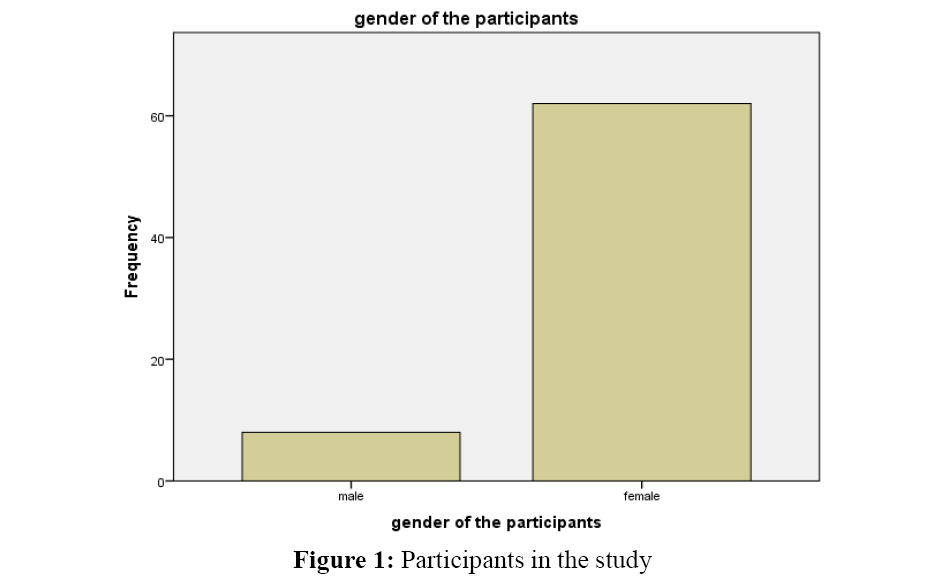
Figure 1: Participants in the study
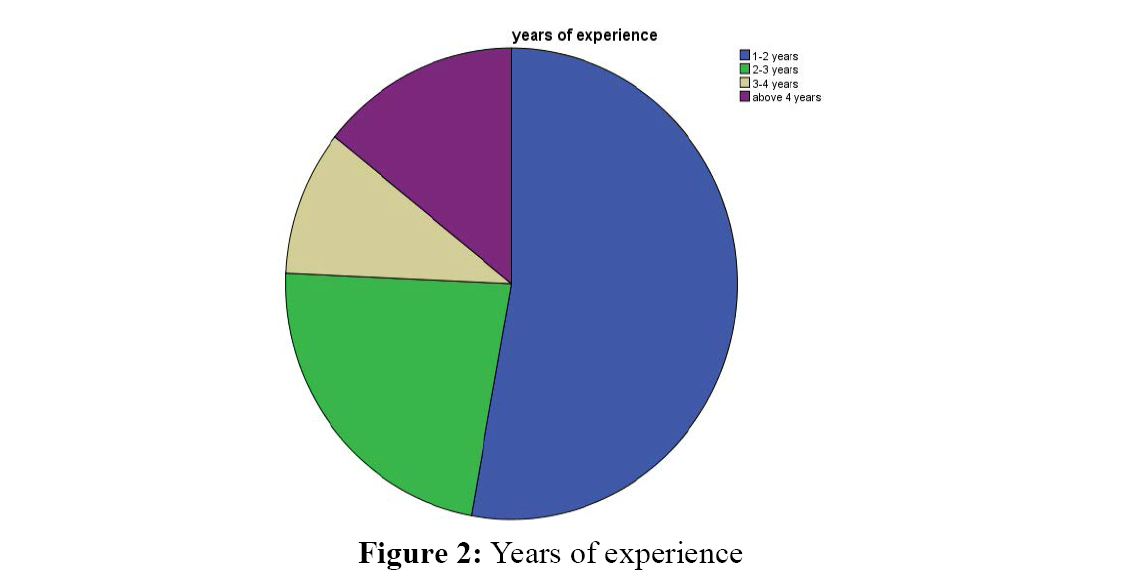
Figure 2: Years of experience
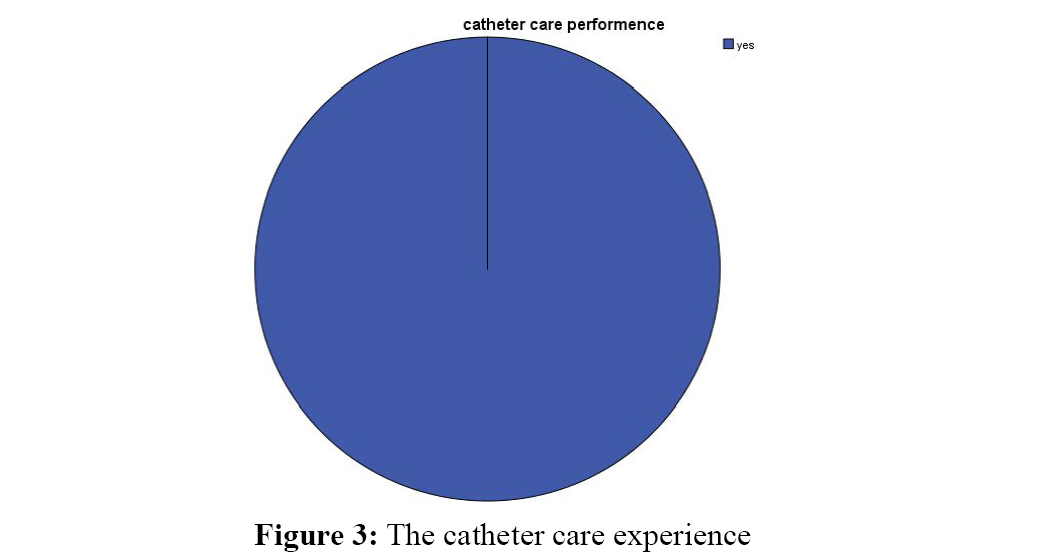
Figure 3: The catheter care experience Figure
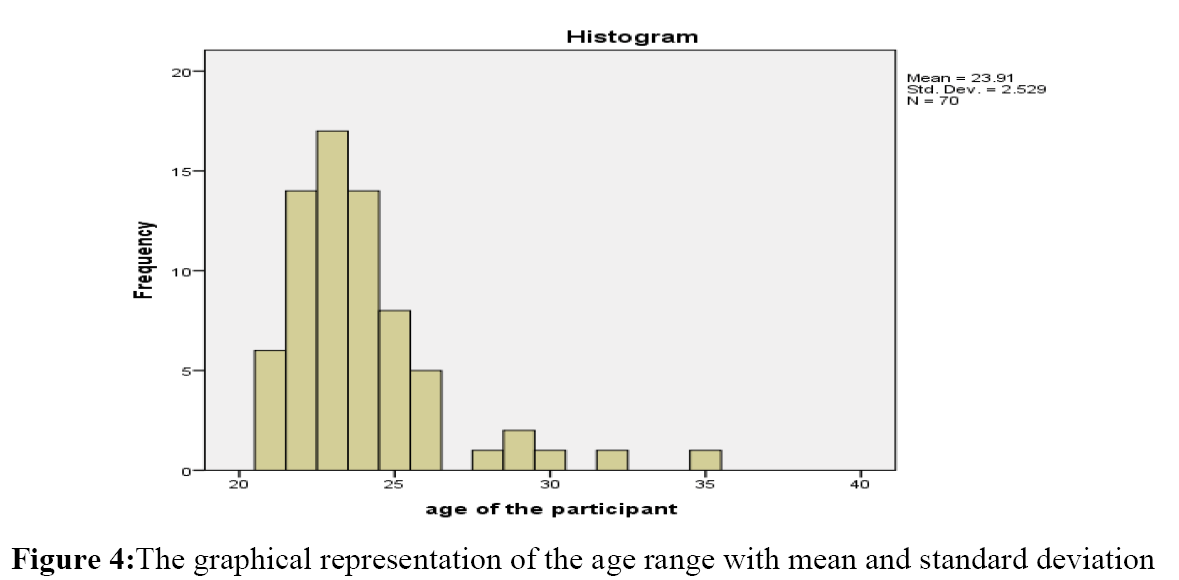
Figure 4: The graphical representation of the age range with mean and standard deviation
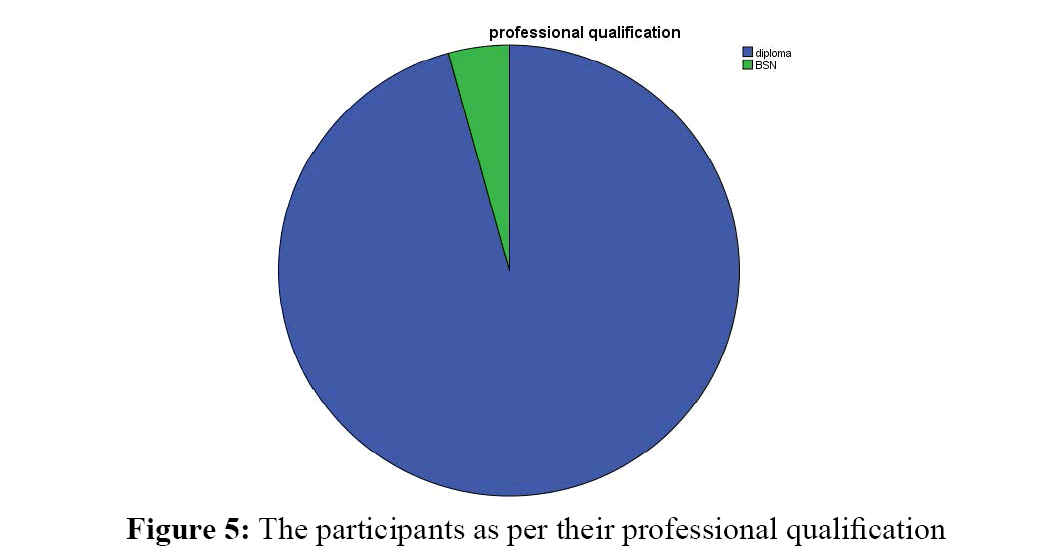
Figure 5: The participants as per their professional qualification
The Mean knowledge and practise with Standard deviation was also calculated, where the Mean knowledge of participants was 66% with standard deviation 25.3%, while the Mean practise was 56.43% with Standard deviation 14.94%. The graphical representation are given in (Figure 6) and (Figure 7) respectively.
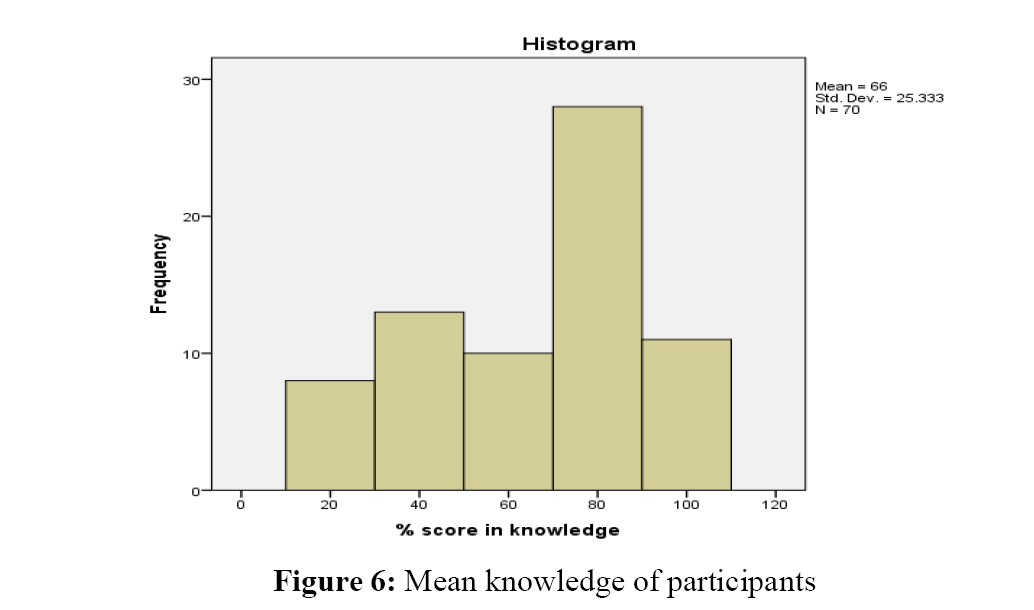
Figure 6: Mean knowledge of participants
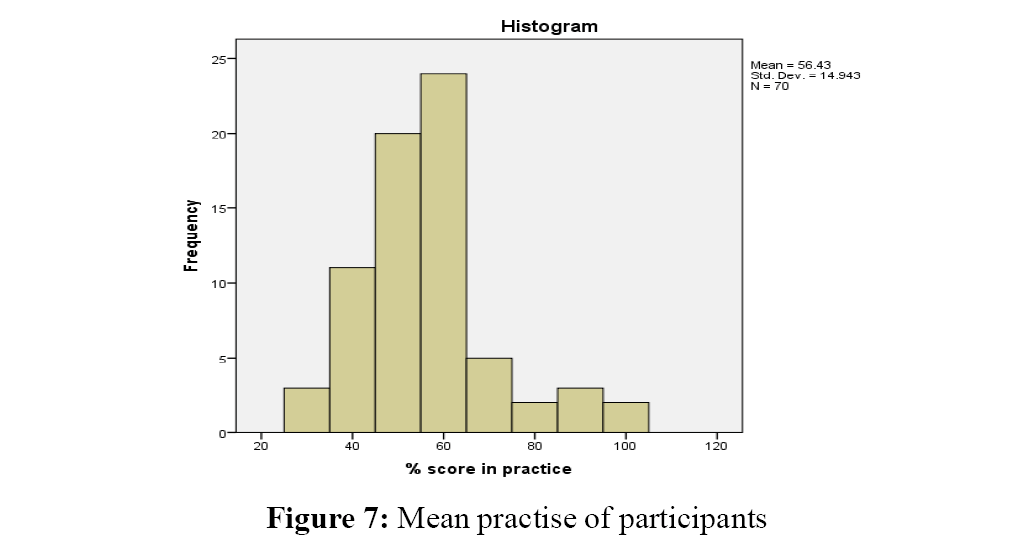
Figure 7: Mean practise of participants
Furthermore, Independent t-test was applied to identify the association between knowledge of participants with year of experience which was not significant.
One- way ANOVA test was applied to identify association between knowledge with year of practise which was significant p=0.024.
The overall percentage of questions regarding knowledge and practise is given in (Table 1).
Table 1: The overall percentage of questions regarding knowledge and practice
| S. No. |
Question regarding knowledge |
Yes |
No |
Don’t know |
| 1 |
Do you know about urinary tract infection (UTI)? |
90.1% |
7% |
2.9% |
| 2 |
Do you know the different types of urinary catheters? |
60% |
24.3% |
15.7% |
| 3 |
Do you know about silicon catheter? |
67.1% |
20% |
12.9% |
| 4 |
Are silicon preferable than Teflon-coated and latex materials in reducing the risk of injury for long term catheterized patient who have frequent obstruction? |
50% |
24.3% |
25.7% |
| 5 |
Do you know immunocompromised client at highest risk of mortality related to urinary catheter infection? |
57.1% |
14.3% |
28.6% |
| |
Question regarding practice |
Yes |
No |
Don’t know |
| 1 |
Do you change indwelling catheter or drainage bags when required? |
87.1% |
10% |
2.9% |
| 2 |
Does metal cleansing with antiseptic solution post catheterization provide greater advantage in preventing the incidence of catheter associated UTI? |
50% |
32.9% |
17.1% |
| 3 |
Do you use standard guidelines for catheter care? |
48.6% |
42.9% |
8.6% |
| 4 |
Do you use lubricant during catheter insertion? |
71.4% |
15.7% |
12.9% |
| 5 |
Do you know the best practices for preventing CAUTI associated with obstructed urinary catheters? |
40% |
30% |
30% |
| 6 |
Do you perform hand washing or used any sanitizer while passing urethral catheter? |
70% |
17.1% |
12.9% |
| 8 |
Do you inject sterile water into needless port to inflate the balloon? |
77.1% |
14.3% |
8.6% |
| 9 |
Do you offer antimicrobial prophylaxis for patients with long term catheterization? |
32.9% |
44.3% |
22.9% |
| 10 |
Do you properly secure indwelling catheters after insertion to prevent movement and urethral traction? |
17.1% |
31.4% |
51.4% |
Discussion
Literature was searched thoroughly about infection control in the use of urethral catheter; knowledge and practise of nurses. A number of studies were found in different countries of the world.
A study on 306 nurses in South Korea indicated that nurses’ knowledge about the basic concepts of infection control and environmental management remained inadequate. Nurses are relatively non-compliant to the guidelines in the field of education (staff, patients, family) and communication. Similarly current study mean was 66% with standard deviation 25.3% regarding knowledge of nurses was also inadequate.
A study in Nellore India indicated that the majority of nurses (46.7%) had adequate knowledge (33.3%) had moderately adequate knowledge and (20%) had inadequate knowledge regarding urinary catheter care. While the current study means knowledge was (66%) with standard deviation (25.3%) adequate and (34%) with standard deviation (25.3%) inadequate.
A study in United States of America revealed that in order to complement the CDC/HSHN goal of decreasing CAUTI rates up to 70% using evidence-based guidelines it is imperative to engage and support frontline nursing staff in evidence-based research. While current study resulted that 48.6% nurses had knowledge regarding standard guidelines.
Urinary catheter insertions should be done in aseptic technique and sterile equipment should be used (CDC, 2012). Moreover, half of 50% had good practises in the number of times cleansing with antiseptic solution and half of 50% had poor practises.
A study conducted in Philippines showed that 60% did not know that using alcohol hand sanitizer was comparable to hand washing in preventing CAUTI. While this study showed that 70% of nurses know that using alcohol hand sanitizer was comparable to hand washing in preventive CAUTI.
Conclusion
This study was conducted in private tertiary care hospital Peshawar. The study was focused on infection control in the use of urethral catheter regarding knowledge and practise of nurses. The result was alarming to know that the nurses had low knowledge and poor practises about infection control in the use of urethral catheter. This study also indicated that nurses need to be educated and trained more on infection control in the use of urethral catheter and associated UTI.
References
- Acharya AS, Khandekar J, Sharma A, et al. Awareness and practices of standard precautions for infection control among nurses in a tertiary care hospital. Nurs J India CIV. 2013;6:31-5.
- Dailly S. Prevention of indwelling catheter associated urinary tract infections. Nurs Older People. 2011;23(2):1419.
- Drekonja DM, Kuskowski MA, Johnson JR. Internet survey of Foley catheter practices and knowledge among Minnesota nurses. Am J Infect Control. 2010;38(1):31-7.
- Fink R, Gilmartin H, Richard A, et al. Indwelling urinary catheter management and catheter-associated urinary tract infection prevention practices in nurses improving care for health system elders hospitals. Am J Infect Control. 2011;40(8):715-7.
- Gordon PR. The effects of nursing education on decreasing catheter associated urinary tract infection rates. Walden University Scholar Works, Walden Dissertations and Doctoral Studies. 2015.
- Lin GG, Scott JG. Investigations of the constitutive overexpression of CYP6D1 in the permethrin resistant LPR strain of house fly (Musca domestica). Pestic Biochem Physiol. 2011;100(2):130-4.
- Oman KS, Makic MBF, Fink R, et al. Nurse-directed interventions to reduce catheter-associated urinary tract infections. Am J Infect Control. 2012;40(6):548-53.
- Opina MLF, Oducado RMF. Infection control in the use of urethral catheters: Knowledge and practices of nurses in a private hospital in Iloilo city. Asia Pacific Journal of Education. 2014;1(5):93-100.
- Prasanna K, Radhika M. Knowledge regarding catheter care among staff nurses. International Journal of Applied Research. 2015;1(8):182-6.
- Umscheid CA, Mitchell MD, Doshi JA, et al. Estimating the proportion of healthcare-associated infections that are reasonably preventable and the related mortality and costs. Infect Control Hosp Epidemiol: The Official Journal of the Society of Hospital Epidemiologists of America. 2011;32(2):101-14.








